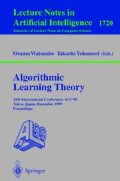Abstract
The neuroidal tabula rasa (NTR) as a hypothetical device which is capable of performing tasks related to cognitive processes in the brain was introduced by L.G. Valiant in 1994. Neuroidal nets represent a computational model of the NTR. Their basic computational element is a kind of a programmable neuron called neuroid. Essentially it is a combination of a standard threshold element with a mechanism that allows modification of the neuroid’s computational behaviour. This is done by changing its state and the settings of its weights and of threshold in the course of computation. The computational power of an NTR crucially depends both on the functional properties of the underlying update mechanism that allows changing of neuroidal parameters and on the universe of allowable weights. We will define instances of neuroids for which the computational power of the respective finite-size NTR ranges from that of finite automata, through Turing machines, upto that of a certain restricted type of BSS machines that possess super-Turing computational power. The latter two results are surprising since similar results were known to hold only for certain kinds of analog neural networks.
This research was supported by GA ČR Grant No. 201/98/0717
Access this chapter
Tax calculation will be finalised at checkout
Purchases are for personal use only
Preview
Unable to display preview. Download preview PDF.
References
Blum, M. — Cucker, F. — Shub, M. — Smale, M.: Complexity and Real Computation. Springer, New York, 1997, 453 p.
Hopcroft, J.E. — Ullman, J. D.: Formal Languages and their Relation to Automata. Addison-Wesley, Reading, Mass., 1969
Indyk, P.: Optimal Simulation of Automata by Neural Nets. Proc. of the 12th Annual Symp. on Theoretical Aspects of Computer Science STACS’95, LNCS Vol. 900, pp. 337–348, 1995
Siegelmann, H. T. — Sonntag, E.D.: On Computational Power of Neural Networks. J. Comput. Syst. Sci., Vol. 50, No. 1, 1995, pp. 132–150
Šíma, J. — Wiedermann, J.: Theory of Neuromata. Journal of the ACM, Vol. 45, No. 1, 1998, pp. 155–178
Valiant, L.: Functionality in Neural Nets. Proc. of the 7th Nat. Conf. on Art. Intelligence, AAAI, Morgan Kaufmann, San Mateo, CA, 1988, pp. 629–634
Valiant, L.G.: Circuits of the Mind. Oxford University Press, New York, Oxford, 1994, 237 p., ISBN 0-19-508936-X
Valiant, L.G.: Cognitive Computation (Extended Abstract). In: Proc. of the 38th IEEE Symp. on Fond. of Comp. Sci., IEEE Press, 1995, p. 2–3
Wiedermann, J.: Simulated Cognition: A Gauntlet Thrown to Computer Science. To appear in ACM Computing Surveys, 1999
Author information
Authors and Affiliations
Editor information
Editors and Affiliations
Rights and permissions
Copyright information
© 1999 Springer-Verlag Berlin Heidelberg
About this paper
Cite this paper
Wiedermann, J. (1999). The Computational Limits to the Cognitive Power of the Neuroidal Tabula Rasa. In: Watanabe, O., Yokomori, T. (eds) Algorithmic Learning Theory. ALT 1999. Lecture Notes in Computer Science(), vol 1720. Springer, Berlin, Heidelberg. https://doi.org/10.1007/3-540-46769-6_6
Download citation
DOI: https://doi.org/10.1007/3-540-46769-6_6
Published:
Publisher Name: Springer, Berlin, Heidelberg
Print ISBN: 978-3-540-66748-3
Online ISBN: 978-3-540-46769-4
eBook Packages: Springer Book Archive

